Instapage Review: In-Depth
Instapage allows for lots of customization so teams can analyze their audiences and create the opt-in forms and landing pages that will attract business. Simple drag-and-drop functionality makes it easy to edit emails and other marketing campaigns while also organizing contact lists.
Key Features
- A/B Testing
- Advertising funnels
- Campaign Segmentation
- Landing pages
- Post-click automation
- Website Analytics
Instapage Review: Background Information
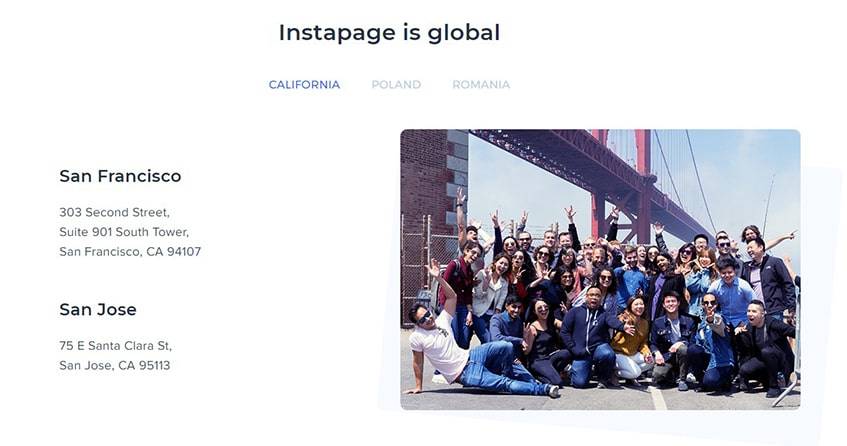
Instapage is a landing page platform founded in 2012 by Tyson Quick. It is headquartered out of San Francisco, U.S.A., and has additional global offices in Poland and Romania. The enterprise partnered with Google in 2018 to create a joint offering: Accelerated Mobile Pages. This is an open-source HTML framework that optimizes webforms sand sites for mobile users. That same year, the business raised $15 million in Series A funding and earned recognition as one of the 5 Best Landing Page Builders.
Service Features & Technical Details
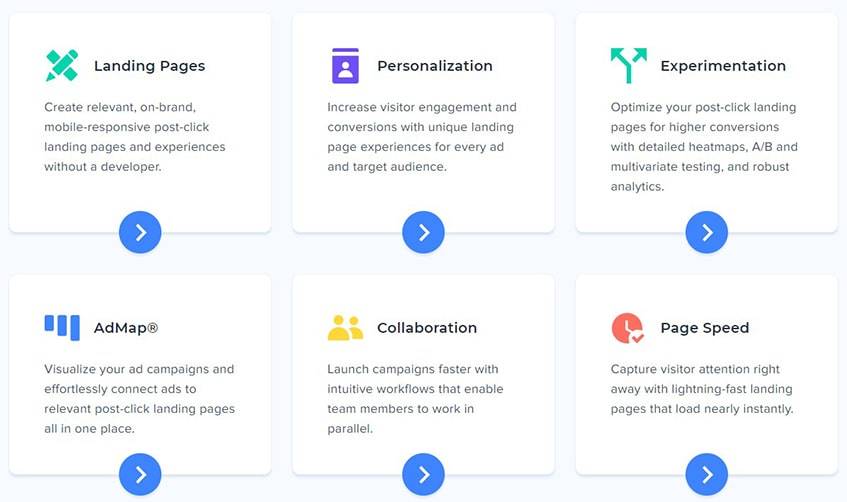
Instapage goes beyond simple landing pages. Here is a closer look at what helped Instapage soar to the top of its field over the years.
A/B Testing
Clients can better personalize their campaigns and forms by running split tests. This allows them to track the competing data and determine which solutions and strategies bring in the most prospects. Through a streamlined process, agencies can boost their conversion rates.
- Create multiple landing pages tailored to a unique audience experience
- Test the outcomes and determine prime variations
- Pair appropriate contact lists to specific post-click experiences
- Use additional tools to add purposeful SEO and media
Heatmap
The AdMap feature is unique to Instapage. It creates a visual representation of each campaign and finds relevant follow-ups based on the campaign ads. This boosts the audience’s pre- and post-click experiences by showing them exactly what they’re interested in.
- See a visual chart of the campaign
- Look through post-click interactions
- Pair them with the relevant digital ads
- Get real-time updates
- Perfect the process for a full customer journey
Landing Pages
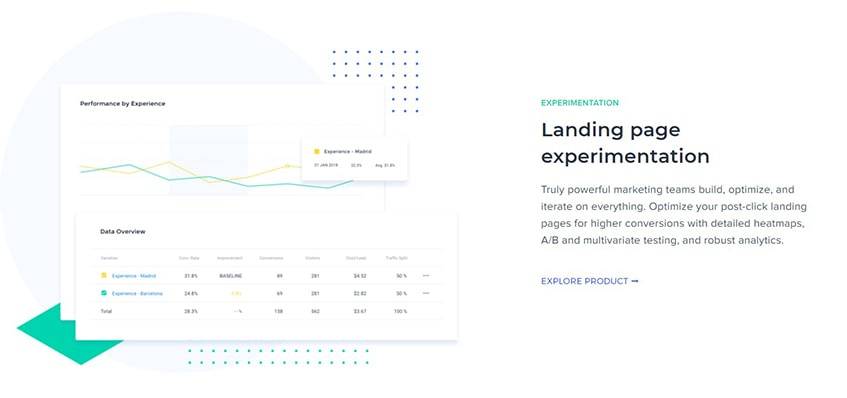
This is where Instapage shines. Agencies can use the landing page toolkit to form customized journeys for their audiences. As soon as someone makes a selection, they’ll go to a landing page built for them. This feature utilizes drag-and-drop technology, so there’s no need to be a computer whiz or web designer.
- Create and/or update in less time
- Collaborate with team members in real-time
- Address up-to-the-minute analytics
- Solidify brand voice and consistency
- Customize WebForms for greater conversion rates
- Use integrations to publish across the Web
Personalization
The more personal an ad or follow-up experience, the higher the conversion rates. Consumers today want authenticity and a listening ear from businesses, so Instapage helps agencies do exactly that. Through 1:1 ad-to-page matching and a seamless editor, companies can expect to increase their ROI, audience engagement, and conversions.
- Capture audience advertising data through Facebook and Google Ads
- Use the information to create personalized follow-ups for each ad/target
- Adjust each lead segment accordingly
- Attach experiences and dynamic content to each contact category
Features in Detail
Here’s a closer look at how all of that customization, designing, and data come together. These tools work together to make the digital advertising world less intimidating. Plus, everything that agencies need is included in the system, making it a one-stop-shop for higher conversion rates.
Landing Page Builder
On the dashboard, clients can create forms and groups. To make the former, individuals can use the provided templates on the platform or import their preferred designs. From there, it’s a simple drag-and-drop process. Best of all, the editor allows for greater flexibility so customers can place their media and content anywhere they want. They can widgets and buttons and make the page mobile-optimized.
- Drag-and-drop
- Mobile-responsive
- Instablocks
- Pre-designed templates
- Saved designs
Design Templates

There are over 100 customizable layouts that agencies can choose from. Not only that, but they can import their unique creations if they want a different design. Simply browse through the template categories and get started with dragging and dropping content. With the Enterprise package, teams can put even more into their post-click ads to drive conversion higher than ever before. Ideas include:
- Bonus
- Demo request
- Product overview
- Schedule appointment
- Special promotions
- Thank you
- Trial signup
- Waitlist signup
- Webinar/event registration
Drag-and-Drop Functionality
This is one of the most effective components of the campaign editor. Back in the day, companies would have to hire someone to design the landing page or WebForm layout. That would take extra time and cost unnecessary amounts of money. Now, these businesses can profit off of their creations and do it all within the builder.
- Template library
- Import unique content
- Flexible placement
Custom Fields
The elements on someone else’s landing page may not be relevant to other businesses’ brand images or goals. That’s why this brand offers more customization. The builder interface allows them to select from different displays and layouts as well as edit those features to their liking.
- Text
- Button style
- Fonts
- Custom JavaScript
Instablocks
Most agencies are working with more than one landing page, and Instablocks is a wonderful new resource for those situations. It’s a huge timesaver that lets team members continue using a library of reusable assets (“blocks”) that can go into later campaigns. There are pre-designed templates to choose from, or individuals can upload their unique creations. This works for:
- Calls-to-action
- Feedback forms
- Opt-ins
- Page headers
- Website testimonials
- And more
Website Widgets
Widgets are necessary for this day and age. Fortunately, it’s easy to add one to an Instapage creation. The dashboard has a sidebar with a widget icon on it. This brings up the available options, which clients can drag and drop into the campaign. These may not be as in-depth and convenient as the widgets on WordPress, but they get the job done and save time in the process. They have the flexibility to place them anywhere on the canvas as well as modify their given action.
- Boxes
- Buttons
- Forms
- Headlines
- Images
- Paragraphs
- Timers
- Videos
Publishing Editor
After they create their landing pages in the editing tool, clients can explore Instapage’s publishing options. Before they commit to one, they can preview the look to make sure it’s exactly what they want.
They can publish on:
- A WordPress site (requires a free plugin)
- An integrated Drupal testing site
- Their custom domain
Mobile-Optimized Design Layouts
Consumers have taken to their phones and handheld devices for news, shopping, and more. It only makes sense to offer mobile-responsive web pages. Every creation on the platform is automatically optimized for mobile, plus teams can view the phone version while they’re working in the editor. This gives them a better feel for how the experience looks on the customer’s end. This could be a bit better, though, as there are limited modifications that agencies can employ. Rather, they can simply hide elements from the Web version, so they don’t show up on mobile.
- Flexible placement
- Pre-built designs
- Reusable content
- Widgets
Syncing to WordPress
Publishing to WordPress is a common option for users, even if it’s simply to preview the landing page. If they choose this option, individuals can access the free plugin on Instapage and sync WordPress to their Instapage account. This is simple enough. From there, they can select the chosen landing page to publish from the WordPress dashboard. It should be available in the publishing drop-down menu. The process is pretty much the same for Drupal customers. They can display the page as a few different things:
- 404 error page
- Landing page
- Website/company homepage
Custom Domains
Now, what if clients want to publish their creation on a custom URL? They can go to the settings menu and click on the domains tab. From there, they can add as many domains and subdomains as they like. There’s a “Connect Domain” button in the top-left corner for them to start with. It’s possible on many different hosting platforms, and there is no limit.
- Bluehost
- DreamHost
- GoDaddy
- HostGator
- Intuit
- Yahoo Small Business
- And others
Reporting
As soon as agencies publish their content, they can begin analyzing their performance. The system’s reports include a built-in heatmap that shows audience behavior and interactions. This makes it much easier to spot holes in the landing page, like non-functional or hidden buttons. The map will also show conversion rates, and customers can integrate Google Analytics for more in-depth insights. The addition of split testing means teams can find that perfect balance between engagement and promotion. Some ways clients are using the platform for that:
- Clicks
- Scrolling
- Views
- Website visits
Integrated Apps
Like any good digital advertising platform, Instapage offers lots of integrations. There are apps for reports, email marketing automation, webinars, sales promotion, and more. Even if someone’s preferred third-party app isn’t available, the platform syncs with Zapier, which opens the door to more integration.
- AdRoll
- Drift
- Facebook Ads
- Google Analytics
- Marketo
- PayPal
- Salesforce CRM
- Shopify
- Stripe
- Trustpilot
- Zapier
Additional Features
Instapage offers plenty of personalization, reporting, and editing tools. This is a sampling of what paying customers can expect. For instance, the user dashboard is open to group collaboration and messaging as well as a document library. The integrations range from sales and CRM to digital marketing to automation. Don’t forget about the Accelerated Mobile Pages, which Instapages worked on with Google back in 2018.
- 404 redirects
- AdMap
- Dynamic text replacement
- DPR compliance
- Google single sign-on
- Hubspot integration
- Post-click score
- Speed Boost
- Split testing
- SSL encryption
Online Training
Customers can get additional assistance and resources via the system’s webinars. There are dozens of topics to explore, from lead management to marketing strategies and ROI tracking. The webinars are hosted by employees, adding a personal touch to the endeavor, not to mention some insider tips.
Plans & Pricing
All of these Instapage functionalities sound great, but teams may be wondering about the price of all these bells and whistles. Below is a run-down of the costs involved and what to expect from each payment plan.
#1 Business: Prime Editing Tools, Basic Analytics
This self-service version of Instapage allows clients to create custom campaigns and modify their pages and forms to suit their target audiences. They can access dozens of templates and layouts to save time as well as use the unique Instablocks feature to save reusable assets. While there is ROI tracking, advanced reports are reserved for the Enterprise plan.
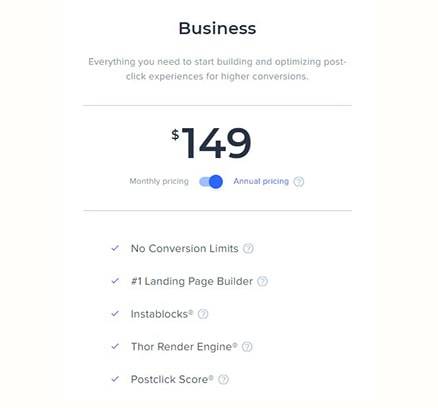
Number of Users: 5
Number of Social Accounts: 5
Scheduling: Yes
Price: $149/mo
- Dozens of design templates
- Instablocks
- Over 40 integrations
- ROI reports
- Up to 30 published pages
- Limited support
- No advanced analytics
#2 Enterprise: Custom Workflows for Streamlined Campaigns
With the Enterprise option, agencies get complete access to the integrations, customization, and a dedicated Customer Success Manager. They’ll also enjoy 1:1 ad-to-page personalization and the ability to use AMPs’ customer service management tools. Employees can take advantage of private workspaces as well as real-time collaboration. The analytics on this plan are more in-depth and also show cost-per-metric information.
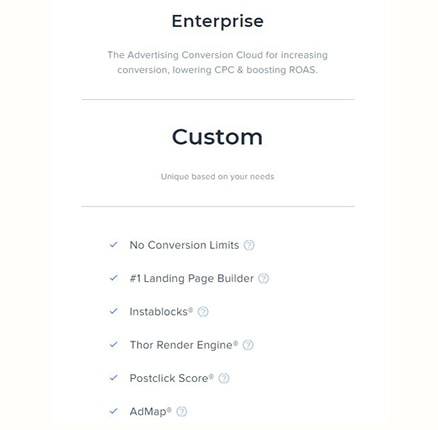
Number of Users: 5+
Number of Social Accounts: 5+
Scheduling: Yes
Price: Custom
- A complete portfolio of integrated apps
- Access to a Customer Success Manager
- AMP and 1:1 ad-to-page personalization
- Fully customized to the company size
- Private workspaces
- Add-ons still cost extra
- The price depends on team size
Pricing & Key Features Comparison Chart
Companies of all shapes and sizes may want to check out Instapage’s packages. Depending on their focus and how many audiences they’re reaching out to, the custom Enterprise plan could be a great fit. Otherwise, the Business plan does a good job of providing useful strategies and tools.
| Business | Enterprise | |
|---|---|---|
| Price | $149/mo | Custom |
| Number of users | 5 | 5+ |
| A/B testing | Yes | Yes |
| Ad-to-page personalization | No | Yes |
| AdMap | Yes | Yes |
| AMPs | No | Yes |
| Conversion analytics | Yes | Yes |
| Custom implementation | No | Yes |
| Instabloks | Yes | Yes |
| Integrations | Limited | Yes |
| Page redirects | Yes | Yes |
| Post-click score | Yes | Yes |
| Visual collaboration | No | Yes |
Terms & Conditions

Instapage’s Terms of Service were last updated at the end of 2019. The terms state that all information and data stored on the platform are collected. Users are prohibited from screen or web-scraping, nor can they extract data from the website for internal use. There is no warranty on the products and services offered, and the brand does not assume liability for inaccuracies. Those who wish to cancel their account may email [email protected].
Privacy Policy
The privacy policy was last updated in November 2019. It states that the company collects all data provided by customers, either through sign-up, correspondence with the staff, or in their workflows. It also gathers third-party information to better understand how clients use these integrations. All data collection complies with legal requirements and restrictions. The business may send promotional and marketing content to users if they express consent.
Refund Policy
The enterprise has a strict refund policy, which can be found on the Terms of Service page. It states that if customers cancel their account within 24 hours of placing their order, they are eligible for a refund. Otherwise, the payment is non-refundable, and the service will continue until the subscription period is over.
Customer Support
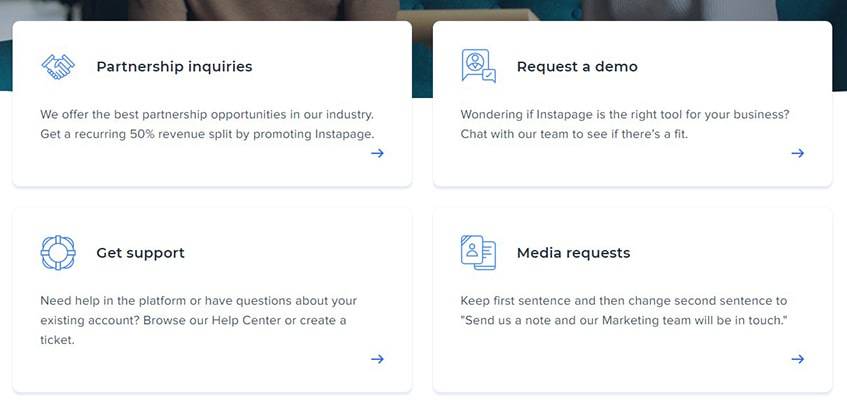
There are a couple of ways to get in touch with Instapage support staff. Keep in mind that the headquarters is located in San Francisco, U.S.A, but there are regional offices in Poland and Romania.
Telephone
There is no phone information on the business’s website. That said, the office addresses are listed, so individuals could technically look up the locations and find contact info that way. Otherwise, they will have to work with the email addresses provided or the help center on the website.
There are two primary email addresses that most customers or prospective clients would be interested in. The first is [email protected], which can hook individuals up with a sales representative who can answer questions about pricing. The other is [email protected], which is for more general queries.
Online Chat
There is not an online chat feature on the website, but individuals may request a demo to get a better idea of what the service has to offer. There is also a request form on the “Contact Us” page, so people can fill that out and get a prompt response.
Support Center
The Help Center is full of blog posts, articles, videos, and other tutorials that potential and current customers can browse through. The search bar at the top of the page makes it even easier to find information about a specific topic. Visitors can scroll to the bottom of this page to view answers to some frequently asked questions or to submit a request ticket.
Quality of Service
The 359 reviews on Trustpilot provide an average score of 2.5 out of five stars. That said, 71% of reviewers gave the service an “excellent” rating. The majority of the complaints report that the interface is a bit difficult to use and prone to glitches. Others weren’t satisfied with the pricing. Most tech experts and marketing insiders agree that this system is powerful and makes publishing click-through pages a whole lot easier. The major drawback is the pricing.
Customer Types
Glancing at the pricing plan models, it seems that there is a specific client in mind. Here is who would take best to this system and who would be better off someplace else.
Small Businesses
A smaller company may find the $149 per month to be doable, but they should make sure that they’ll have access to enough features before signing up. Consider that this base plan doesn’t include all integrations and analytics.
Mid-Sized Companies
A medium-sized business is more likely to take on packages. Depending on how many contacts they have, the base plan might suit them well enough. They can send content to up to 30,000 contacts and access ROI trackers, split testing, and over 40 integrated apps.
Large Enterprises
A bigger company could look into the brand’s Enterprise package. The pricing isn’t clear on the website, and it looks like individual clients will have to get custom quotes. Larger businesses are most likely going to need this tailor-made package if they want to take full advantage of the sales and marketing toolkits.
Freelancers
Almost undoubtedly, freelancers will need to take their projects elsewhere. Even the low plan may be too expensive for most contractors to swing, and that’s okay. There are plenty of service alternatives, which are described down below.
Pros & Cons
This platform is a powerful option, not only for building landing pages but for implementing custom content like opt-in forms, email campaigns, page redirects, and new sales promotions. It’s also nice that the system offers mobile-responsive features and access to various widgets and plugins. The downside, besides the pricing, is that the Instapage base plan has limited flexibility and review options.
Pros
Cons
- Advanced landing page builder with drag-and-drop functionality
- Lots of analytics ad real-time updates
- Mobile-optimized content
- Professional design and layout templates
- Various publishing options (WordPress, custom)
- Limited options and flexibility on the Business plan (30,000 unique visitors per month)
- There are great integrations, but not as many as other competitors have
Service Alternatives
Since there seems to be a niche market for Instapage, it may be helpful to look at some of the service alternatives out there.
Unbounce: Speedier Conversion Rates That Stick
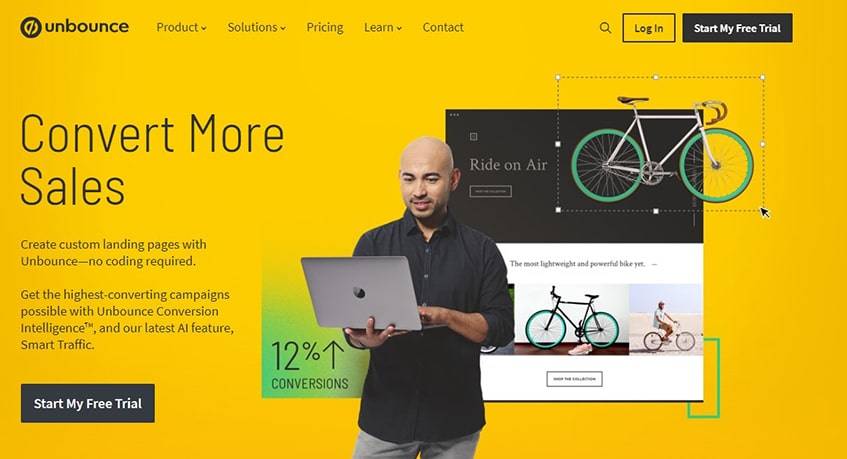
While Unbounce’s base plan lacks page redirects and AMPs, it still offers lots of security features and a great email builder with templates. Even on the lower-tiered package, clients can have unlimited users and access to hands-on customer support.
Leadpages: Helping Small Businesses Stay in Front of Audiences
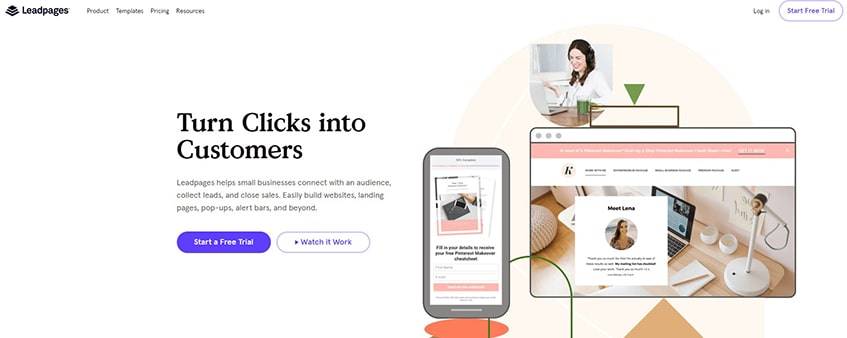
Leadpages has a convenient starter kit for $15 per month. Those that sign on to the annual payment plan get access to a free custom domain, too. While these are the bare basics, it does include unlimited traffic and leads, weekly group coaching, and mobile-responsive templates like its competitor.
ClickFunnels: A One-Stop-Shop for Sales Funnels
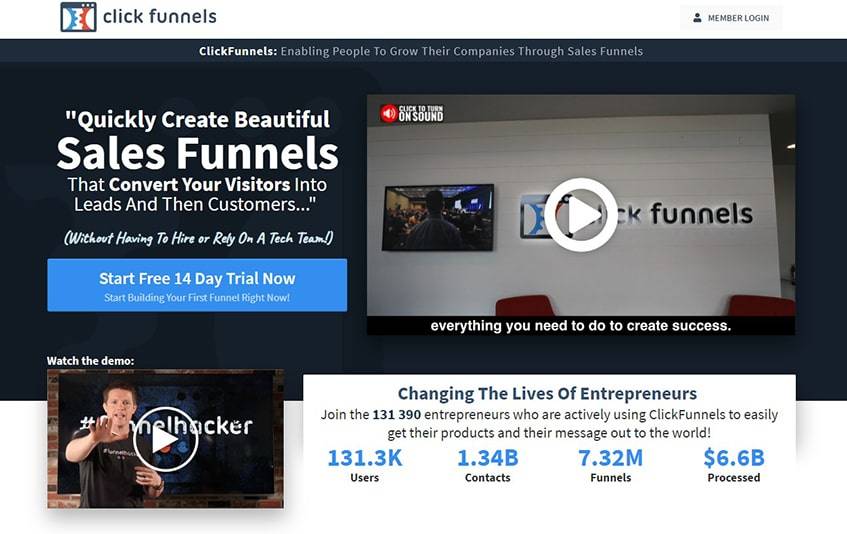
For businesses that have their eyes on the (sales) prize, ClickFunnel is the way to go. The platform works with agencies, freelancers, bloggers, coaches, and consultants to help them sell more products and get in front and center of their target audience.
Landingi: Click-Through Pages & Layouts For Non-Programmers

Landingi is recommended by expert blogger Neil Patel. Users can build and publish new pages, manage leads, automate key marketing tasks, review reports, and more. The analytics allow teams to refine and optimize their content to drive more conversions and sales.
Squarespace: A Full Website Builder With Analytics
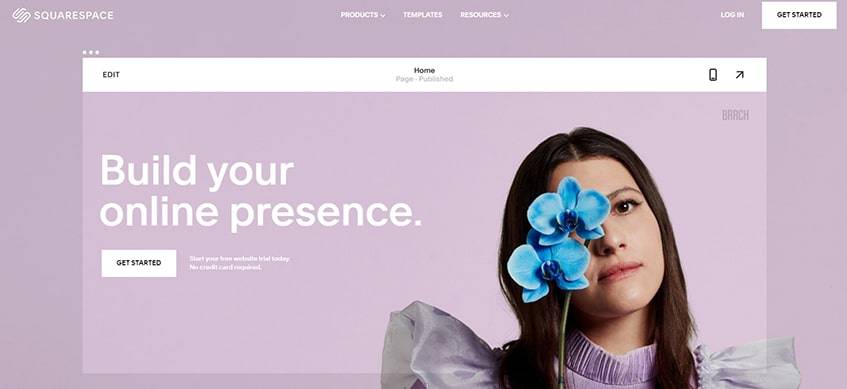
Squarespace is a favorite among bloggers, and it’s easy to see why. Features include SEO and tracking tools, mobile editing, and integrations with Zapier, YouTube, Dropbox, and more. Folks can use and review it for free before signing on to the premium plan.
Wix: Designer Templates, Editors, & Custom Domains

Wix’s base plan may be a bit skimpy, but the pricing is on point. Features include over 500 designer-made templates, the seamless Wix Editor, built-in SEO, mobile optimization, and third-party API and integrations. It’s worth four dollars more each month to upgrade to the Business package.
Instapage & Alternatives Comparison Table
The prices and features in this comparison chart refer to the base packages of each provider. Check out the side-by-side view to see which platforms the best suit the team’s specific needs.
InstapageUnbounceLeadpagesClick FunnelLandingiSquare SpaceWix
| Price | $149/mo | $79/mo | $15/mo | $97/mo | $29/mo | $16/mo | $13/mo |
| A/B testing | Yes | Yes | No | Yes | No | No | No |
| Conversion analytics | Yes | Yes | Yes | Yes | Yes | Yes | Yes |
| CRM | Yes | No | No | Yes | No | No | No |
| Custom implementation | No | No | Yes | Yes | Yes | Yes | No |
| Dynamic text replacement | Yes | Yes | No | No | Yes | Yes | No |
| Integrations | Yes | Yes | Yes | Yes | Yes | Yes | Yes |
| Post-click scores | Yes | No | No | No | Yes | No | No |
| Templates | Yes | Yes | Yes | Yes | Yes | Yes | Yes |
| WebForms | Yes | No | Yes | Yes | Yes | Yes | Yes |
Frequently Asked Questions
How Do You Use Instapage?
The primary focus of the Instapage platform is to create capture pages, so let’s start there.
- Go into the dashboard and begin using any of the dozens of unique and stunning template designs. Alternatively, choose “blank” to make one from scratch.
- In the editor panel tool, add whichever features best suit the goal of the page. Examples include headlines, Instablocks, images, videos, buttons, and forms.
- Go to “settings” on the left-hand side to customize the HTML or Javascript. This is optional.
- Finish and publish it on WordPress or a custom URL.
What is the Best Landing Page Builder?
It depends on what the person or agency is looking for. The service alternatives are a great place to start if people think that Instapage might not be for them. Some folks do a lot of blogging, so they might look into Squarespace or Wix. Others are all about CRM and conversions, so Pardot could rival Instapage. Again, teams should think about:
- What they need from a provider
- How far along they are in their marketing journey
- What their end goals are
What Should Be on a Landing Page?
This is an excellent question, and different professionals will have their unique answers. That said, a generally successful capture page will include a few key elements, and it’s up to teams to spice it up and make it their own.
- Make it separate from the homepage
- Include a headline
- Have a descriptive paragraph
- Post media (images or video)
- Testimonials, if possible
- Call-to-action
- Clear objectives
- Value to the visitor
Is Instapage a Good Website Builder?
Depending on what the customer wants, Instapage can guide them to higher conversion rates and a more engaging website. It has many of the prime features that make for exciting and valuable landing pages.
- Sales funnels and insights
- Template designs
- Various page elements (forms, pop-ups, page migration, etc.)
Do I Need a Website for a Landing Page?
Technically, no. Websites should have landing pages, but these can also stand on their own. Ideally, the landing page will be part of a website because that will allow the creator to sell their goods and services. Just make sure the page achieves the following:
- Answers a specific question or meets a need
- Offers adequate descriptions
- Includes a call-to-action
Where Power & Productivity Meet to Drive More Sales
There’s no doubt that Instapage is a powerful tool. With its templates, campaign builder, and deep insights and tracking tools, agencies and teams hold power. The price may scare off some new or less-established brands, but those who can afford it will find the dashboard to be chock-full of features, personalization, and publishing options. Have you tried Instapage service or found a worthy alternative? Be sure to let us know in the comments.

